

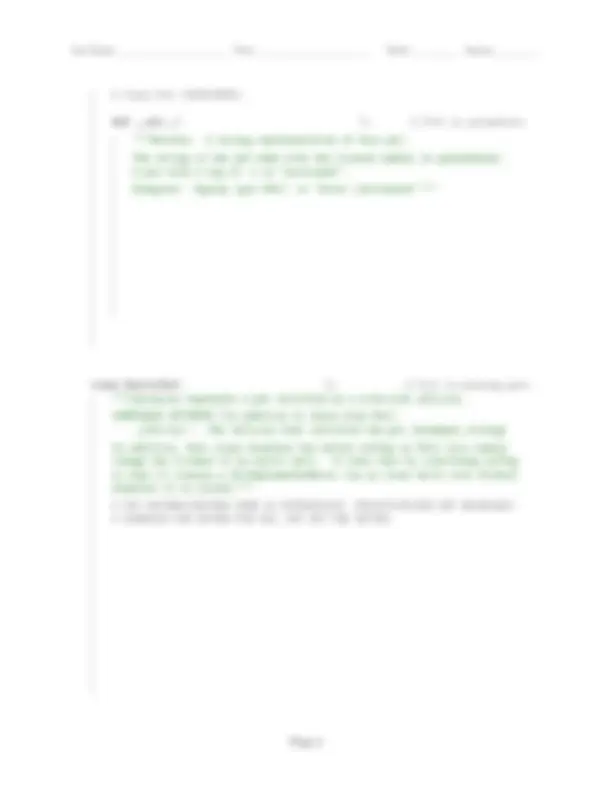
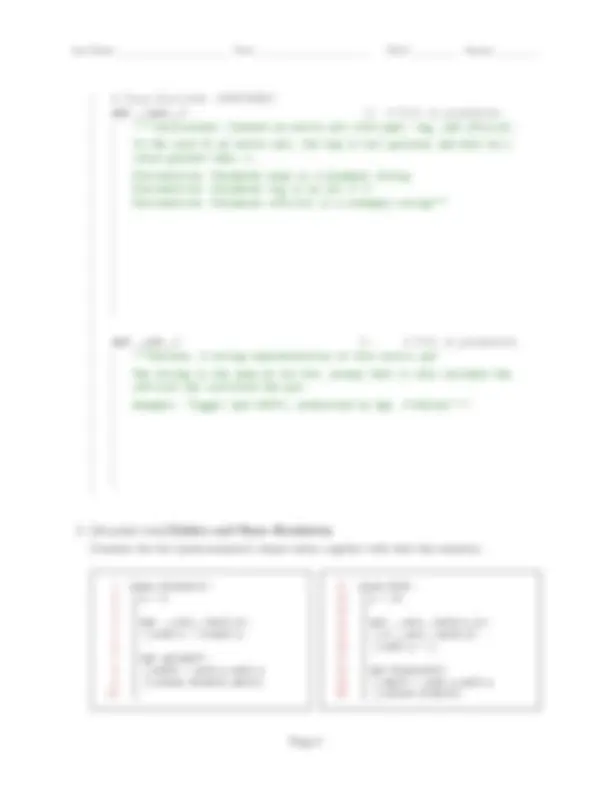
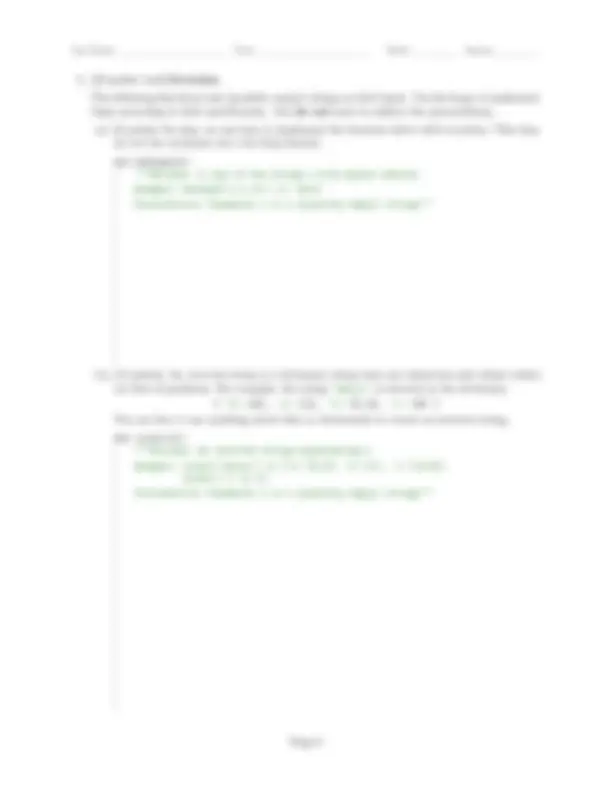
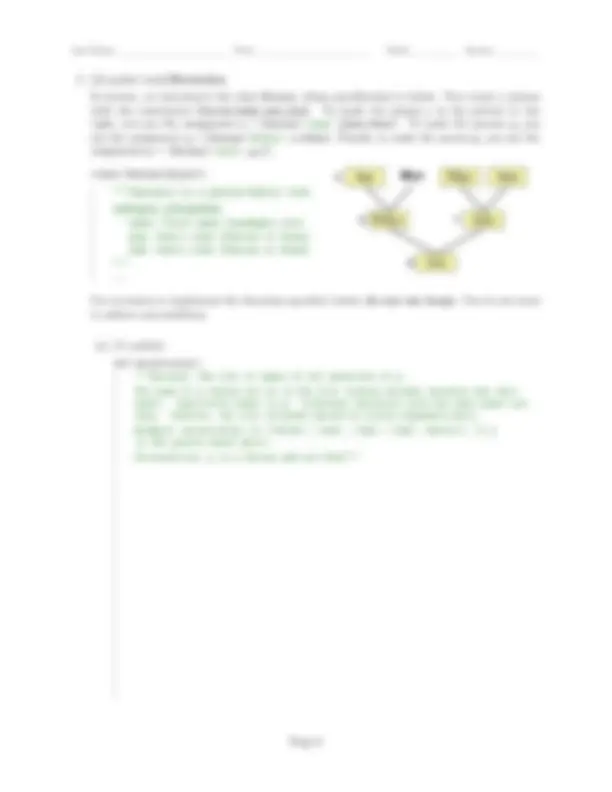
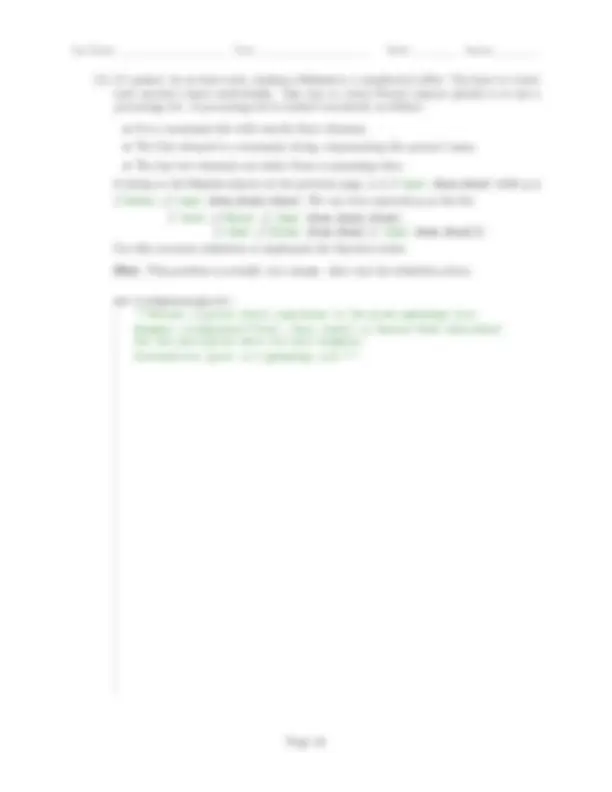


Study with the several resources on Docsity

Earn points by helping other students or get them with a premium plan


Prepare for your exams
Study with the several resources on Docsity

Earn points to download
Earn points by helping other students or get them with a premium plan
Community
Ask the community for help and clear up your study doubts
Discover the best universities in your country according to Docsity users
Free resources
Download our free guides on studying techniques, anxiety management strategies, and thesis advice from Docsity tutors
This is a 90-minute exam for CS 1110 with 5 questions worth a total of 100 points. The exam covers Python string, list, and dictionary functions and methods, classes and subclasses, name resolution, and recursion. Students are expected to write Python code and follow the Academic Integrity Code.
What you will learn
Typology: Lecture notes
1 / 10

This page cannot be seen from the preview
Don't miss anything!







This 90-minute exam has 5 questions worth a total of 100 points. Scan the whole test before starting. Budget your time wisely. Use the back of the pages if you need more space. You may tear the pages apart; we have a stapler at the front of the room.
It is a violation of the Academic Integrity Code to look at any exam other than your own, look at any reference material, or otherwise give or receive unauthorized help.
You will be expected to write Python code on this exam. We recommend that you draw vertical lines to make your indentation clear, as follows:
def foo():
if something: do something do more things do something last
You should not use while-loops on this exam. Beyond that, you may use any Python feature that you have learned about in class (if-statements, try-except, lists, for-loops, recursion and so on).
The Important First Question:
String Functions and Methods
Function/Method Description
len(s) Returns: Number of characters in s; it can be 0. s.find(s1) Returns: Index of FIRST occurrence of s1 in s (-1 if s1 is not in s). s.count(s1) Returns: Number of (non-overlapping) occurrences of s1 in s. s.replace(a,b) Returns: A copy of s where all instances of a are replaced with b.
List Functions and Methods Function/Method Description
len(x) Returns: Number of elements in list x; it can be 0. y in x Returns: True if y is in list x; False otherwise. x.index(y) Returns: Index of FIRST occurrence of y in x (error if y is not in x). x.append(y) Adds y to the end of list x. x.insert(i,y) Inserts y at position i in x. Elements after i are shifted to the right. x.remove(y) Removes first item from the list equal to y. (error if y is not in x). x.sort() Rearrages the elements of x to be in ascending order.
Dictionary Functions and Methods
Function/Method Description
len(d) Returns: Number of keys in dictionary d; it can be 0. y in d Returns: True if y is a key d; False otherwise. d.keys() Returns: List containing all the keys in d. d.values() Returns: List containing all the values in d. It may have duplicates.
The next two pages have skeletons of two classes: Pet and ExoticPet. ExoticPet is a subclass of Pet, while Pet is only a subclass of object. You are to
Pay close attention specifications. There are no parameters beyond the ones specified. If a parameter has a default value, it is listed in the specification. There are no headers for getters or setters. You are to write those from scratch. However, you are not expected to write specifications for the getters and setters. Important: ExoticPet must not access the hidden attributes of Pet directly. If you need to access a hidden attribute, use methods from Pet.
def str( ): # Fill in parameters """Returns: A string representation of this pet. The string is the pet name with the license number in parentheses. A pet with a tag of -1 is "unclaimed". Examples: 'Sparky (pet #43)' or 'Rover (unclaimed)'"""
class ExoticPet( ): # Fill in missing part """Instances represent a pet certified by a wild-life official. IMMUTABLE ATTIBUTE (In addition to those from Pet): _official : The official that certified the pet [nonempty string] In addition, this class disables the setter setTag in Pets (you cannot change the license of an exotic pet). It does this by overriding setTag so that it creates a NotImplementedError (an an class built into Python) whenever it is called."""
def init( ): # Fill in parameters """"Initializer: Creates an exotic pet with name, tag, and official. In the case of an exotic pet, the tag is not optional and must be a value greater than -1. Precondition: Parameter name is a nonempty string Precondition: Parameter tag is an int >= 0 Precondition: Parameter official is a nonempty string"""
def str( ): # Fill in parameters """Returns: A string representation of this exotic pet The string is the same as for Pet, except that it also includes the official who certified the pet. Example: 'Tigger (pet #675); authorized by Sgt. O'Malley'"""
Consider the two (undocumented) classes below, together with their line numbers.
1 class A(object): 2 z = 5 3 4 def init(self,x): 5 self.x = x+self.z 6 7 def up(self): 8 shift = self.x-self.z 9 return B(shift,shift) 10
11 class B(A): 12 z = 10 13 14 def init(self,x,y): 15 A.init(self,x) 16 self.y = y 17 18 def down(self): 19 shift = self.x-self.z 20 return A(shift)
3
4
5
6
7
The following functions take (possibly empty) strings as their input. Use for-loops to implement them according to their specification. You do not need to enforce the preconditions. (a) [8 points] In class, we saw how to implement the function below with recursion. This time do not use recursion; use a for-loop instead. def deblank(s): """Returns: A copy of the string s with spaces removed Example: deblank('a b cd') is 'abcd' Precondition: Parameter s is a (possibly empty) string"""
(b) [12 points] An inverted string is a dictionary whose keys are characters and whose values are lists of positions. For example, the string 'hello' is inverted as the dictionary { 'h':[0], 'e':[1], 'l':[2,3], 'o':[4] } You are free to use anything about lists or dictionaries to create an inverted string. def invert(s): """Returns: An inverted string representing s Example: invert('abcac') is {'a':[0,3], 'b':[1], 'c':[2,4]}. invert('') is {}. Precondition: Parameter s is a (possibly empty) string"""
(b) [11 points] As we have seen, making a Person is a complicated affair. You have to create each ancestor object individually. One way to create Person objects quickly is to use a geneaology list. A geneaology list is defined recursively as follows:
Hint: This problem is actually very simple. Just read the definition above.
def list2person(glist): """Return: A person object equivalent to the given genealogy list. Example: list2person(['Fred', None, None]) is Person('Fred',None,None) See the description above for more examples. Precondition: glist is a genealogy list."""